Wave upwelling pumps are an innovative technology that harnesses the power of nature to transform the ocean.
By utilizing the waves to pump up nutrient-rich water from the ocean floor, it promotes the explosive proliferation of phytoplankton, contributing to the revitalization of marine resources.
From summer to autumn, it also helps to prevent the rise in sea surface temperature.
This is a practical solution for combating drastic changes to the marine environment caused by typhoons (hurricanes, cyclones) and heavy rains.
In order to carve out the future together, we are currently looking for participants for this open joint project! Why not take this opportunity to be part of creating the future of our oceans?
Development project participants wanted
Current list of supporters
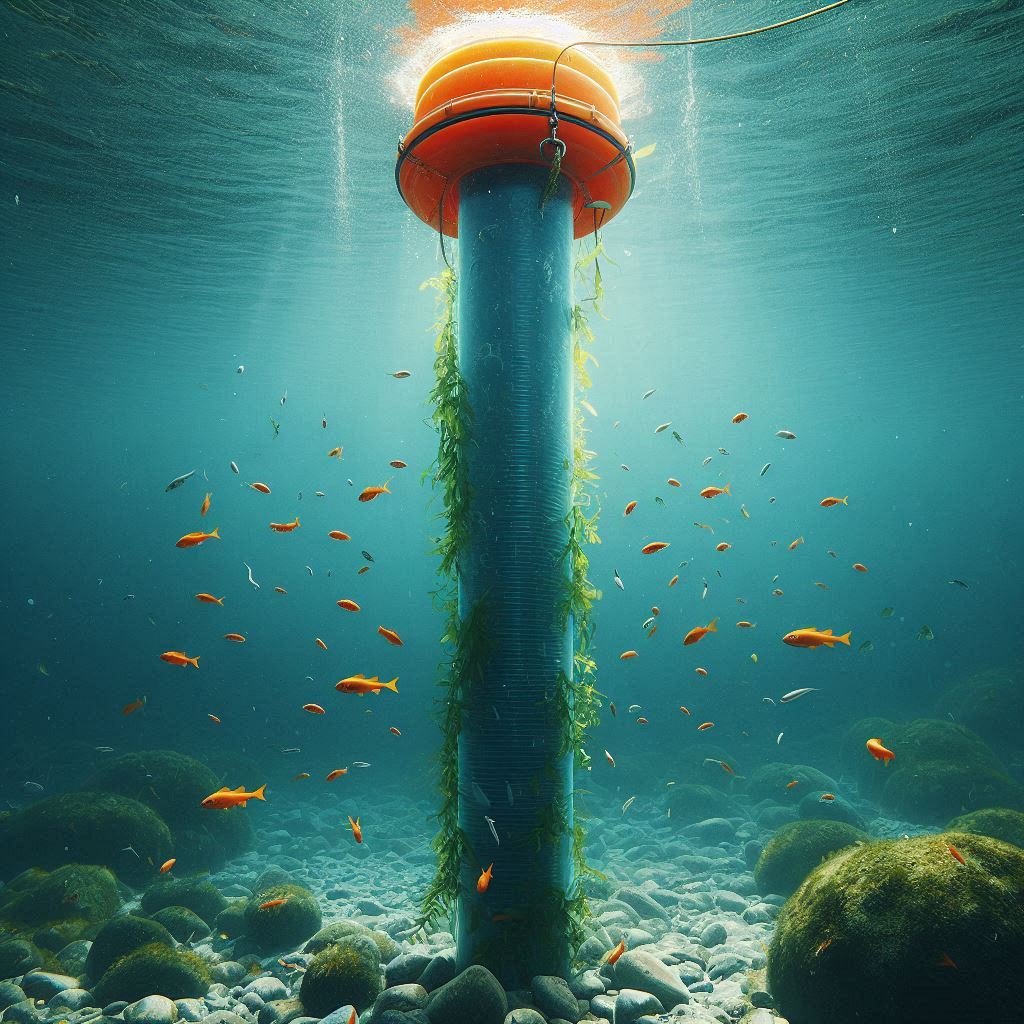
Fishing reef effect
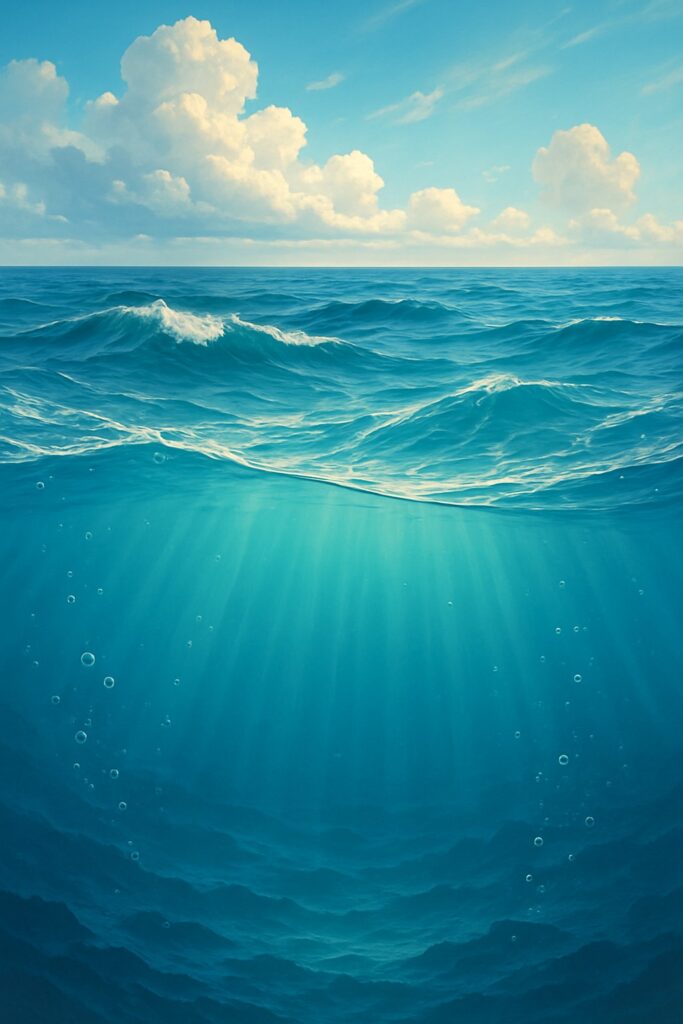
seawater stirring
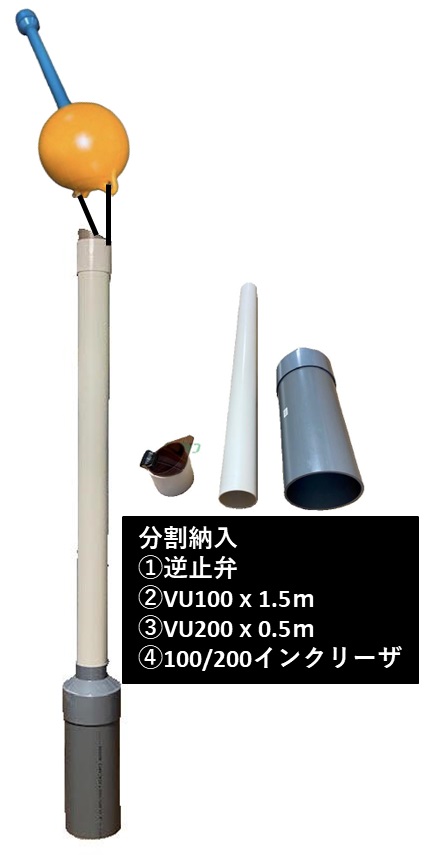
Sales equipment
Main features
- Zero energy : Powered only by wave and wind power, no external energy required! Sustainable technology with zero environmental impact
- Explosive revitalization of fishery resources : Promoting oxygen and nutrient circulation and creating an artificially rich upwelling area
- Defense against climate change : Cooling sea surface temperatures and suppressing typhoons (hurricanes, cyclones) and heavy rains
- Low cost and DIY : Supporting new business ventures for fisheries industry players and revitalizing the local economy
- Reduce the damage caused by heatstroke : Lower the sea surface temperature in urban coastal waters and mitigate the effects of extreme heat with sea breezes
Novelty of the project
1. Use of shallow water for cooling = Equipment can be made smaller and more decentralized
Ise Bay has a layer of cold water 2 to 3 meters deep. By using the force of the waves to pump this cold water to the surface and stir it up, the sea surface temperature is lowered.
As a result, the generation of water vapor is reduced, which helps control the development of typhoons, hurricanes, and cyclones.
At the same time, it will increase the amount of oxygen taken up into the ocean, helping to prevent fish and shellfish from dying from lack of oxygen.
Comparison of water temperature by depth in Ise Bay: Depth 0.1m to Depth 24m, August 1, 2024
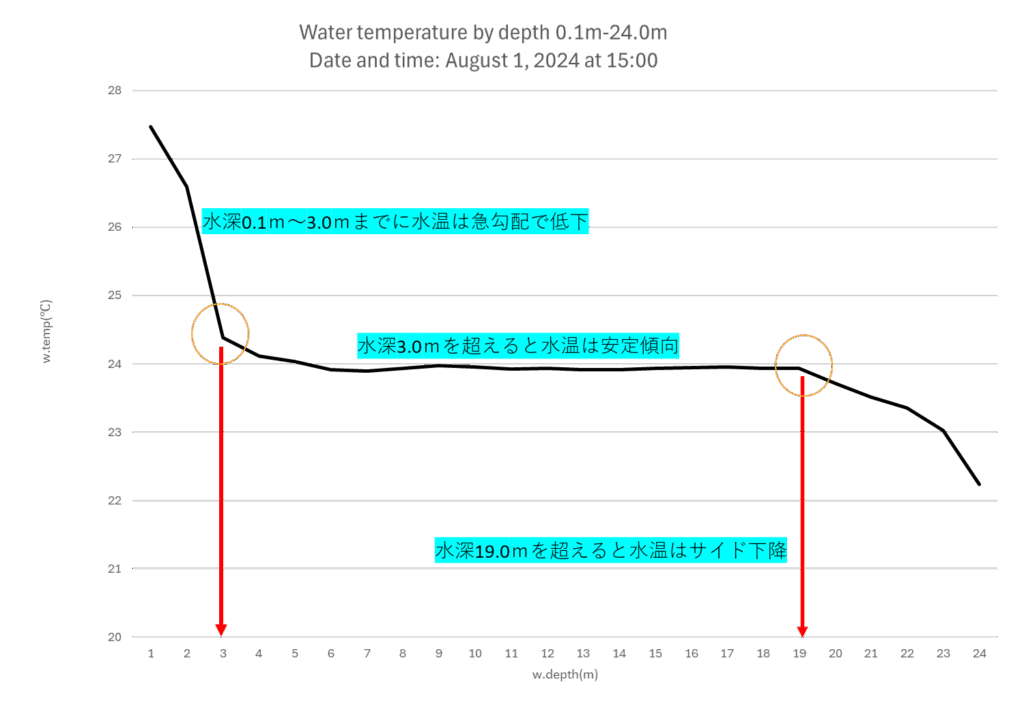
Comparison of water temperatures at depths of 0.1m and 3m in Ise Bay: August 1st to August 29th, 2024
*Circle: Sea surface temperature drops as the typhoon passes through
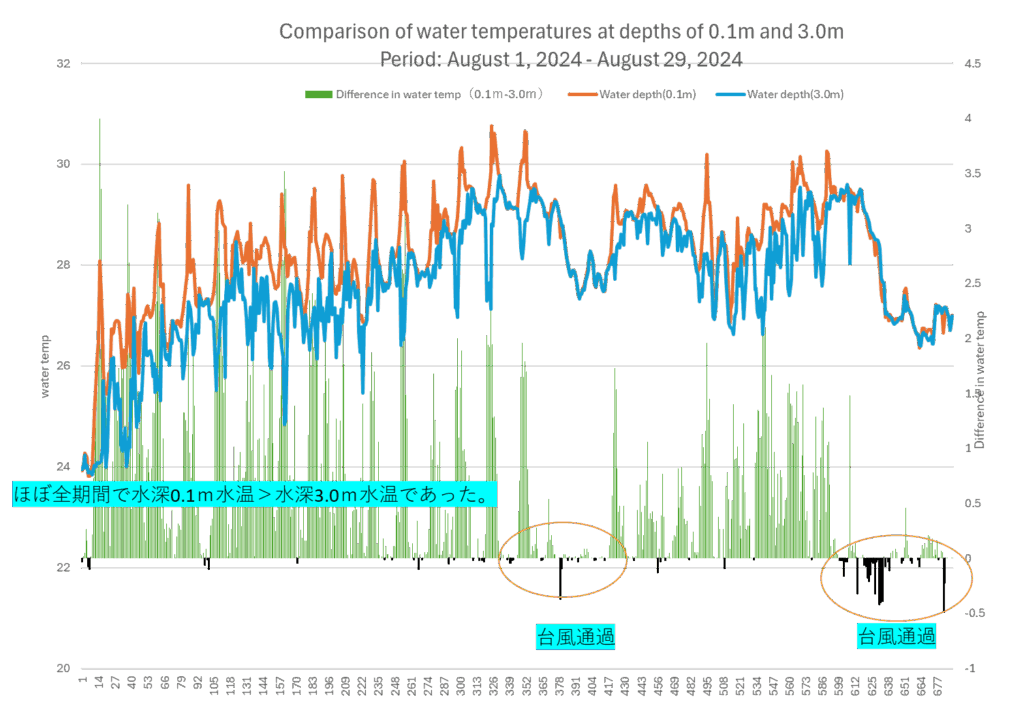
2. Floating fishing reef creation = Creating seaweed beds and restoring the ecosystem
Seaweed epiphytic
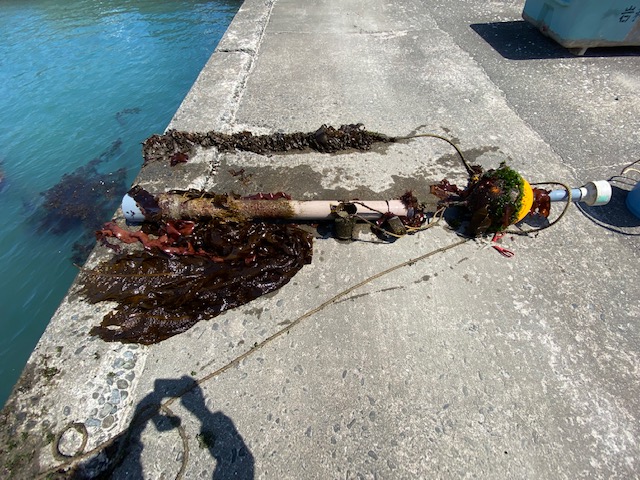
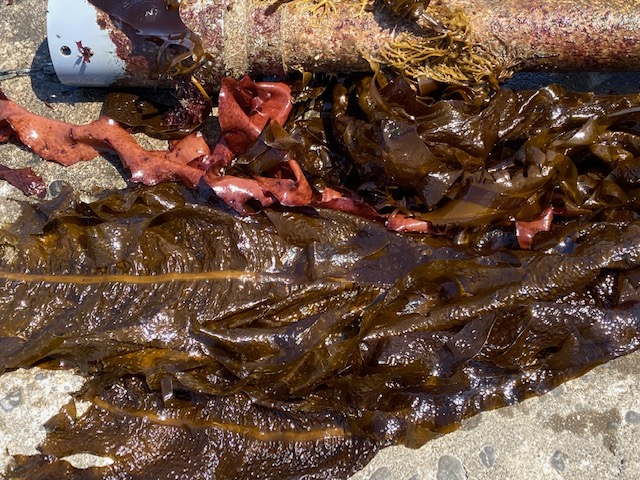
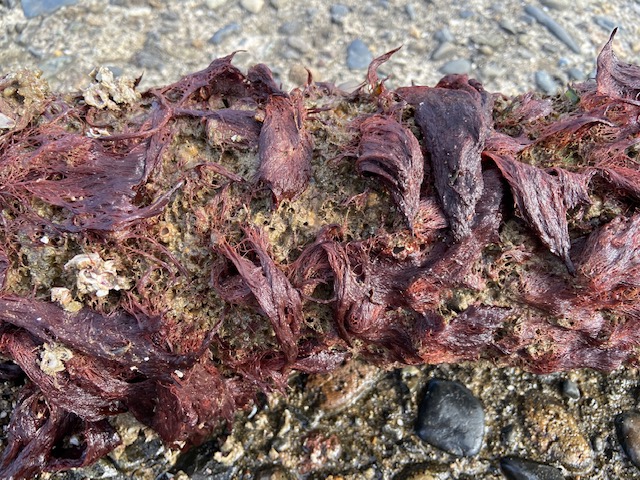
Confirmation of a diverse ecosystem

It serves as a spawning site.

Further information, table of contents:
What is a wave upwelling pump?
What is the role and effect of a wave upwelling pump?
About NPO Escot’s wave upwelling
pumpLatest videos and materials about wave upwelling pumpsMonitor
sales startCatalog
related information, materials
* About upwelling sea areas = 50% of fishery resources come from 0.1% upwelling sea areas
* About the effect of seabed cultivation (fertilization of the sea)
* About problems caused by rising sea surface temperatures and the cooling effect
* Latest research on sea surface temperatures
* Test sea area: Sea surface at Katsuura Underwater Observatory: Comparison at a depth of 8m
* Estimated upwelling water volume and calculation formula
* About suppressing water vapor supply
* System that can utilize typhoon energy
* Aerobic decomposition of sludge = suppression of methane and blue tide generation
* Aerobic decomposition of organic matter that accumulates in depressions on the sea floor after dredging to suppress the generation of methane and hydrogen sulfide
* Overseas cases
* Summary
NEW: Wave upwelling pump overview manual
⇒ More information
NEW: Poster exhibit at Tokyo Bay Symposium
⇒Detailed information
NEW: We have provided German language materials to several German companies .
⇒German language materials
NEW: The possibility of DAC technology to capture CO2 directly from the air has emerged .
⇒Detailed information
What is a wave upwelling pump?
A wave upwelling pump is an artificial upwelling device that uses the up and down motion of waves to pump seawater (or fresh water).
Principle of wave upwelling:
An upwelling pump is suspended in the ocean from a round buoy floating on the surface and repeatedly moves up and down due to the waves.
① When rising, the upper valve closes, sealing off the upper part of the upwelling tube and rising together with the water inside.
② When descending, the water inside the tube is expelled from the valve due to the inertia of the water and the upward water pressure from the lower part of the upwelling tube.
Figure 1: Illustration of upwelling, source: Shibaura Institute of Technology

Figure 2: Visualization image of upwelling using Tororo kelp, Source: Shibaura Institute of Technology

Figure 3: Underwater image of upwelling. The valve closes when it rises and opens when it descends.

Upwelling area:
Upwelling zones are said to account for only about 0.1% of the total ocean surface area , but their biological productivity is exceptionally high among all marine ecosystems, resulting in the formation of an extremely rich ecosystem. This is because nutrients from the deep sea are brought to the ocean surface, triggering the proliferation of phytoplankton, the producers of the ocean, which in turn increases the number of organisms at higher trophic levels. Upwelling zones also provide good fishing grounds, benefiting humans. Source: Wikipedia
Return to the top of this page
What is the role and effect of a wave upwelling pump?
(1)
Verification test of upwelling efficiency by comparing sea surface temperatures with and without an upwelling pump to suppress sea surface temperature rise
- Test location: Iwawada Fishing Port, Onjuku Town, Chiba Prefecture
- Equipment form: Upwelling pipe VU125, total length 2m
- Verification method: PVC pipes with and without upwelling function (both 2m long) were laid 3m apart and the water temperature changes at depths of 0.2m and 2.0m were compared.
- Measurement interval: 15 minutes
Figure 4: Test implementation diagram

Table 1: One-week vertical water temperature comparison test results = 2023.9.11 to 2023.9.18
*The red band indicates the cooling effect.

Table 2: Results of a one-day vertical water temperature comparison test = September 15, 2023
*The vertical water temperature difference is approximately half
*The cooling effect on sea surface water temperature is most noticeable during the day when there is sunlight.

Example of upwelling calculation:
Use the calculation formula of Griffith University Gold Coast Campus in Australia.
Table 3: Calculation formula of Griffith University Gold Coast Campus

*A is the area of the tube, H is the wave height from trough to crest, and T is the wave period.
Assume that the maximum rising speed of the pump is equal to the maximum rising speed of the water surface.
Theoretical formula for upwelling:
Q_th=πAH/T (-∆ρ/ρ gAT)
(A: pipe cross-sectional area, H: amplitude, T: wave period)
(ρ: water density, ∆ρ: density difference, g: gravitational acceleration)
Since upwelling occurs from a shallow layer, differences in specific gravity due to differences in water temperature can be ignored.
Table 4: Estimation of upwelling amount, improved upwelling pump (= upper pipe diameter 100 mm + lower pipe diameter 200 mm)
* Approximately 450 tons/day at wave height 50 cm, cycle 3 seconds

Estimation of sea surface diffusion area of upwelled water:
*Wave height and period are the same as in Table 4.
*Weather conditions for surface current calculation: Chiba prefecture annual average wind speed is 3.5m/s.
Table 5: Estimated sea surface diffusion area of upwelled water
* Diffusion area (water layer thickness = 0.1m) is approximately 4370m2/day

Figure 5: Depth of diffusion of oxygen and nutrients
It brings nutrients from the lower layers to the ocean surface, helping the proliferation of phytoplankton and revitalizing fishery resources in upwelling areas.
At the same time, it is expected to have the effect of reducing water vapor by diffusing cold water from the lower layers from spring to autumn near the ocean surface.

Figure 6: Test conducted at Ishinomaki scallop farm: Total length approx. 6m, lower part is VU150 pipe

Return to the top of this page
About NPO Escot’s upwelling pump
In 2019, we began developing a check valve type wave upwelling pump.
1. Zero energy/small wave compatible: Powered only by wave power, it can pump low-lying water even with small waves in inland seas, lakes, etc.
2) High strength and durability: The experience gained from previous offshore tests is utilized.
3) Economical and versatile: Upwelling pipes are made of PVC pipes (second-hand pipes are acceptable) and can be obtained anywhere in the country.
4) DIY compatible: People involved in the fishing industry can make, install and repair the equipment themselves.
⑤Low cost: They can be purchased for 100,000 yen (1 set), and a certain number of them can be used as fishing reefs.
⑥Check valve price: 19,800 yen. Upwelling tube, buoy, and rope are general-purpose items.
Figure 7: Structure and upwelling mechanism

Figure 8: Illustration of upwelling conditions

Figure 9: Connected photo

Figure 10: Check valve


Return to the top of this page
Latest videos and materials on wave upwelling pumps
1.Video: Climate change countermeasure mechanism of the wave upwelling device ⇒Click here
2.Video: Explanation of the Wave Upwelling Pump ⇒Click here
3. Video: Video of water upwelling at wave height of 5cm ⇒here *
You can clearly see how the water in the pipe rises by a few centimeters.
4. Video: Visualization of the water flow inside and outside the upwelling pipe ⇒ here
5. Documents: Latest information: Results of an experiment verifying the effectiveness of a wave-type upwelling pump
Monitor sales have started. Catalog ⇒Here
Return to the top of this page
Related information and materials :
*Effects of seabed cultivation (sea fertilization)
Effect 1: Increase in phytoplankton and revitalization of fishery resources
Effect 2: Increased phytoplankton captures CO2
Effect 3: In sludge (marine areas with anaerobic organic matter deposits), it promotes decomposition, helping to prevent red tides and blue tides.
Effect 4: It helps reduce the generation of methane (a greenhouse gas 25 times more potent than CO2) through anaerobic decomposition.

- Plankton increase and CO2 absorption
- Source: University of Hamburg
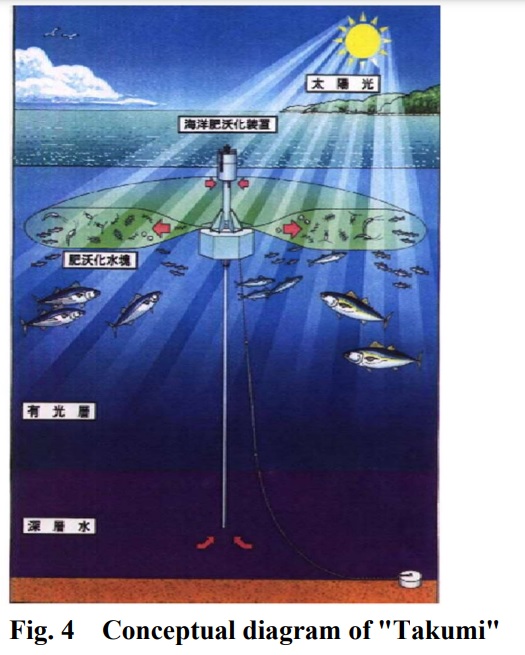
- Artificial upwelling and fish population increase, Takumi
- Source: Japan Institute of Marine Engineering
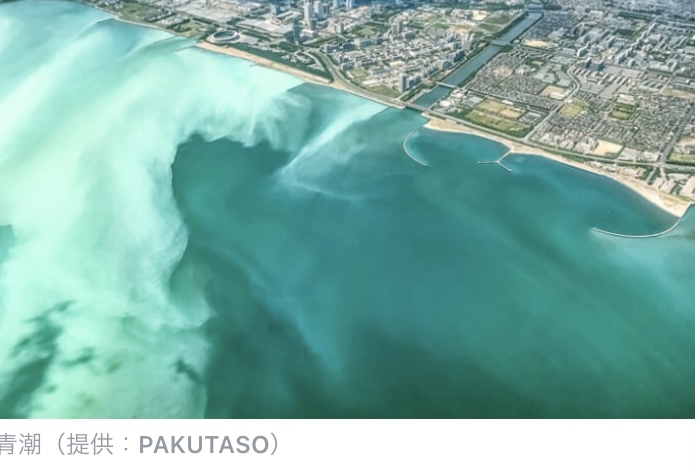
- Blue tide occurs
- Source: PAKUTASO
Return to the top of this page
*The issue of rising sea surface temperatures and the cooling effect
Rising sea surface temperatures can have the following effects:
Climate change and changing weather patterns:
Rising sea surface temperatures can affect weather patterns, for example increasing the intensity and frequency of hurricanes and typhoons.
②Changes in ocean circulation:
Changes in sea surface temperatures can also affect ocean circulation, which can lead to changes in ocean currents and climates around the world.
3) Impact on ecosystems:
Marine ecosystems are sensitive to changes in sea surface temperature. Rising temperatures can affect the distribution, reproduction, and food availability of marine organisms. This can have a particularly severe impact on certain ecosystems, such as coral reefs and fish schools.
④Melting glaciers and ice sheets:
The rise in sea surface temperatures associated with global warming may, in extreme cases, accelerate the melting of glaciers and ice sheets, which could accelerate sea level rise and affect low-lying coastal areas.
⑤ Rising temperatures and related problems:
Rising sea surface temperatures are also associated with rising air temperatures. This could lead to rising temperatures across the globe and an increase in weather events such as heat waves, droughts, and floods.
⑥ Decreased intake of oxygen and CO2 from the air into the ocean: This
could cause a decrease in the amount of dissolved oxygen in the ocean. This could lead to a decrease in the amount of oxygen and CO2 absorbed by the ocean, which could lead to the death of fish and shellfish due to lack of oxygen and a decrease in phytoplankton.
Possible effects of cooling sea surface temperature:
Effect 1: Restriction of water vapor supply
Effect 2: Suppression of typhoons, heavy rains, and heavy snowfall
Effect 3: Measures against heatstroke in coastal cities (heat absorption by low-level cold seawater)
Effect 4: Increase in the amount of oxygen and 2CO dissolved from the ocean surface (increase in plankton and prevent death from lack of oxygen)
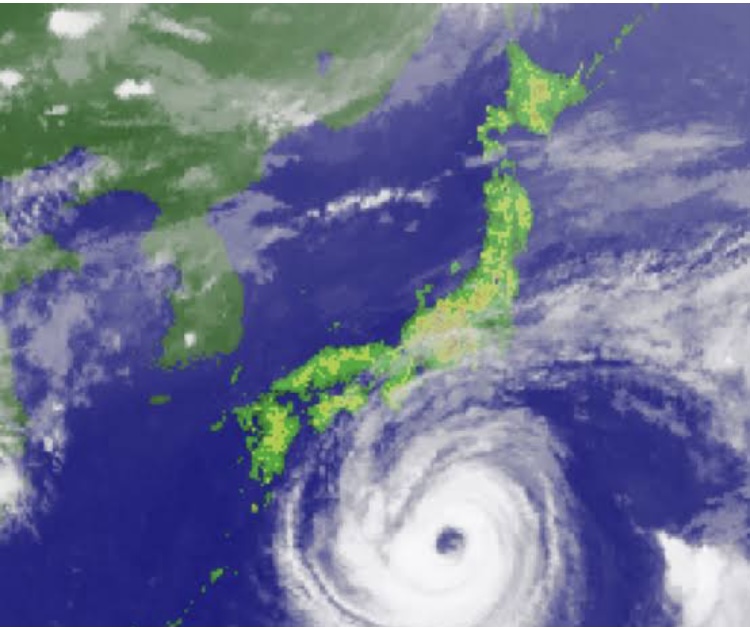
- Japan Meteorological Agency website
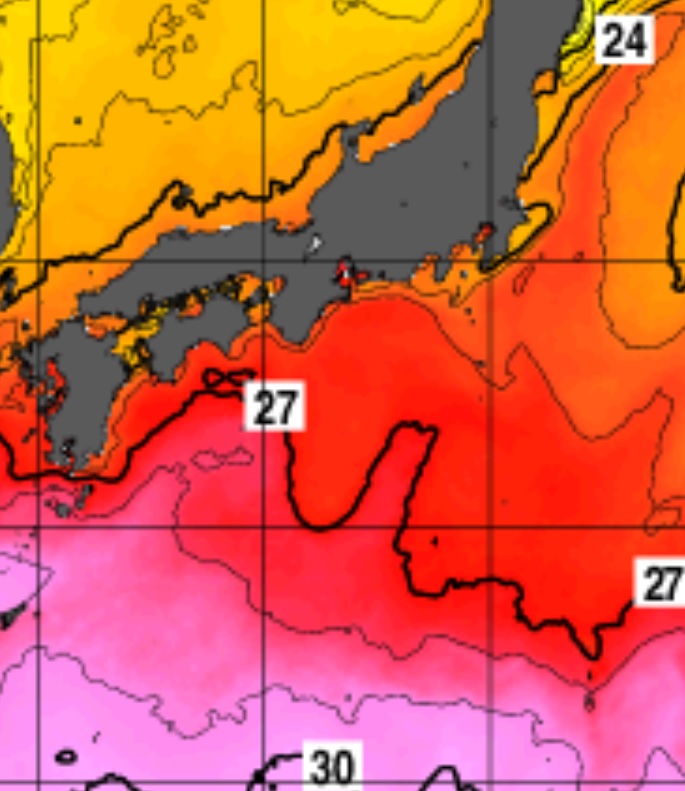
- Japan Meteorological Agency website
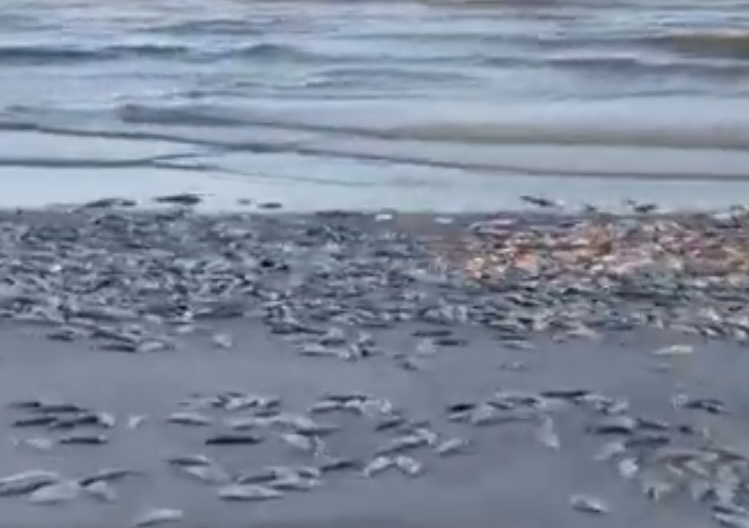
- Source: TV Asahi News
- Mass fish kill in the Gulf of Mexico
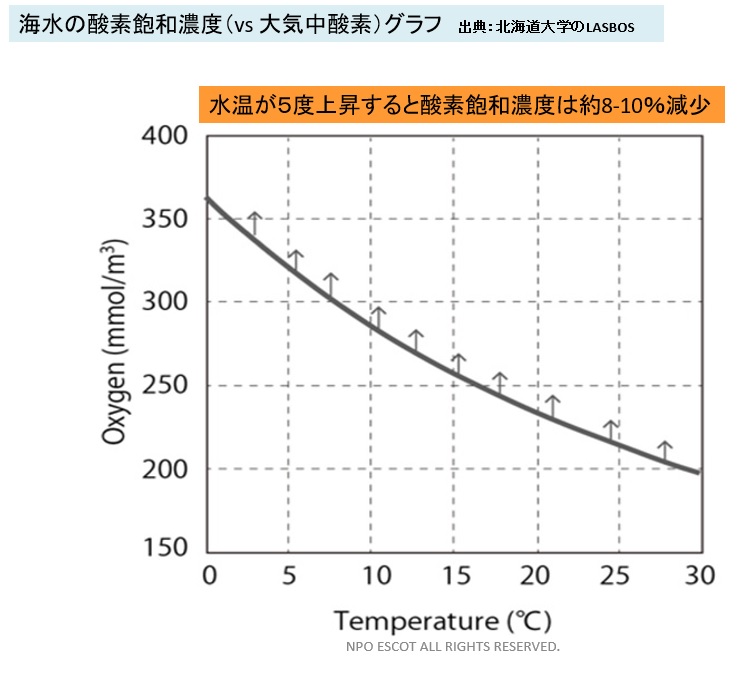
Water temperature and oxygen dissolved amount curve:
When the water temperature increases by 5°C, the amount of oxygen absorbed decreases by 8 to 10%.
Return to the top of this page
*Latest survey results on sea surface temperatures
Due to ocean currents, the temperature in Katsuura, Chiba Prefecture, rarely exceeds 30°C even in summer.
We compared the annual water temperature at 8m depth at the “Undersea Observation Park” in Katsuura with the sea surface temperature data from the Japan Meteorological Agency.
*There was an issue with the collection time of the Japan Meteorological Agency data being unclear.
- The average water temperature difference throughout the year was about 1.7°C higher in the sea surface region.
- The occurrence rate of days when the sea surface temperature was higher than the subsurface temperature was approximately 95%.
- Throughout the year, sea surface temperatures were 3°C or more higher on average in June, July, and August.
- The maximum vertical water temperature difference was 8°C.
- The reduction in water temperature difference in September and October is thought to be due to stirring caused by typhoons.
- It is believed that visibility is low during periods of rising sea surface temperatures due to the proliferation of plankton.
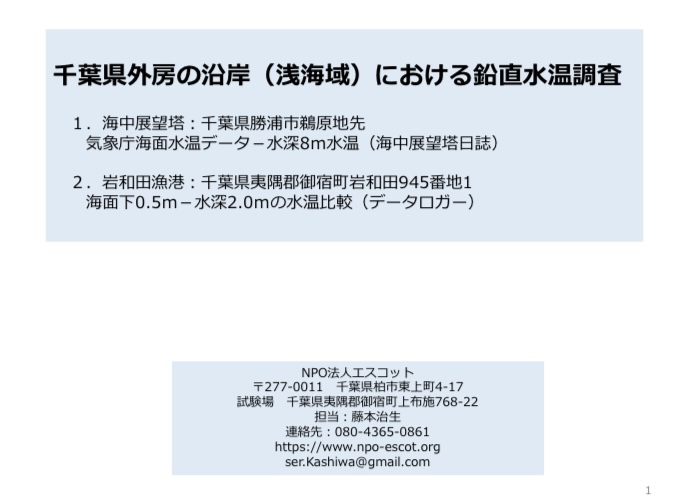
Test area:

Annual vertical water temperature change graph in Katsuura: Red = sea surface water temperature, Blue = water temperature 8m below the surface
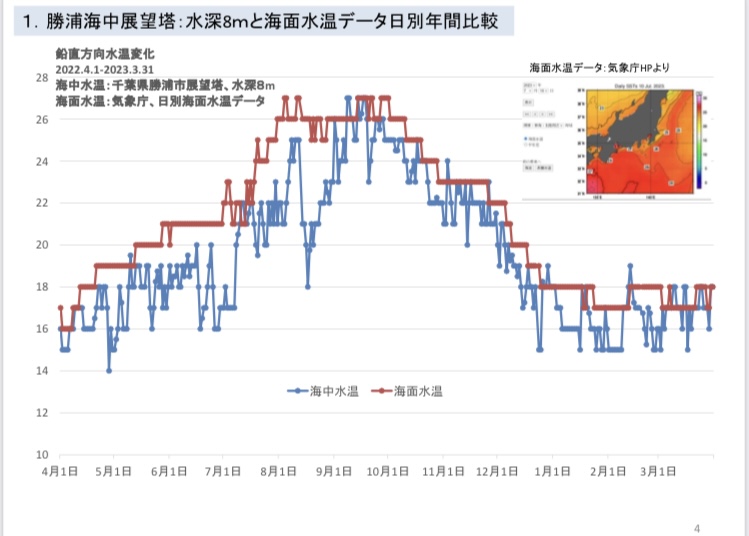
Water temperature difference graph: August is the highest
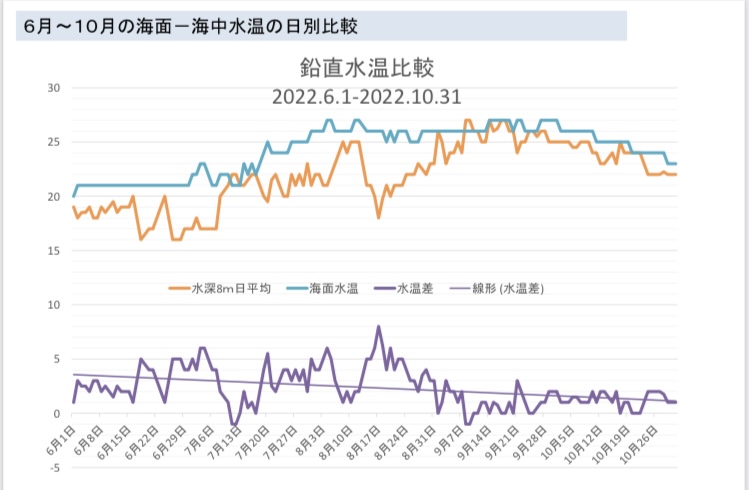
Monthly average water temperature change: Decreased in September and October due to typhoons
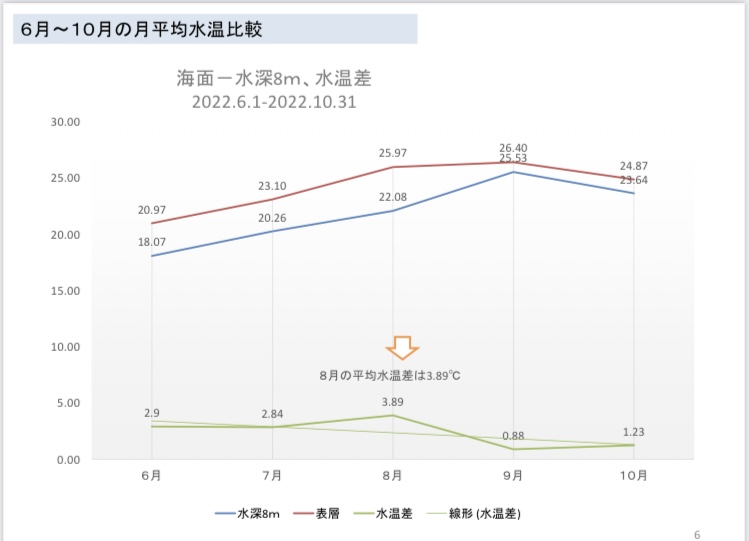
It is believed that the diversion occurred because sea surface temperatures were low from autumn to winter.
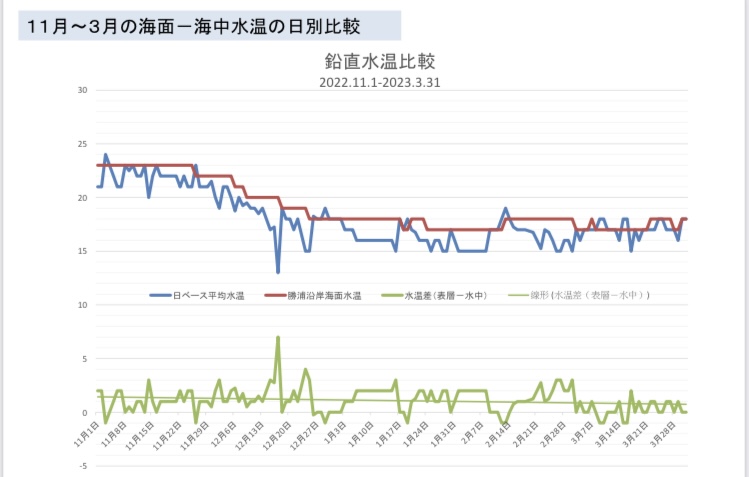
The monthly average water temperature is lowest in January and February.
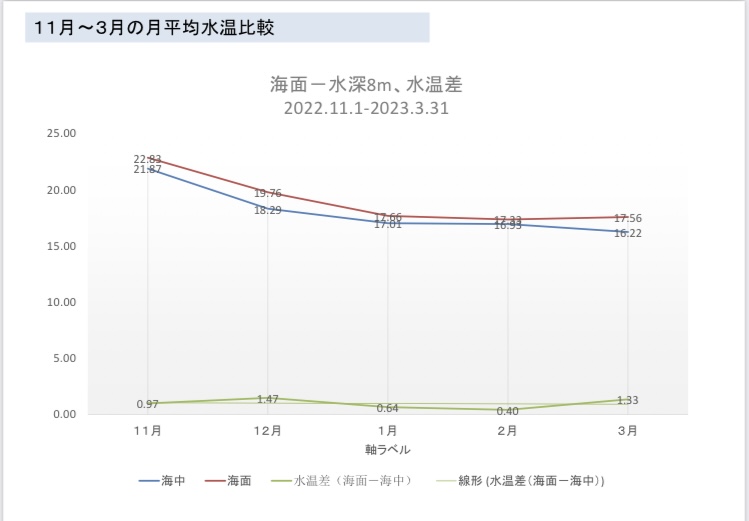
It is believed that plankton influences the relationship between transparency and water temperature.
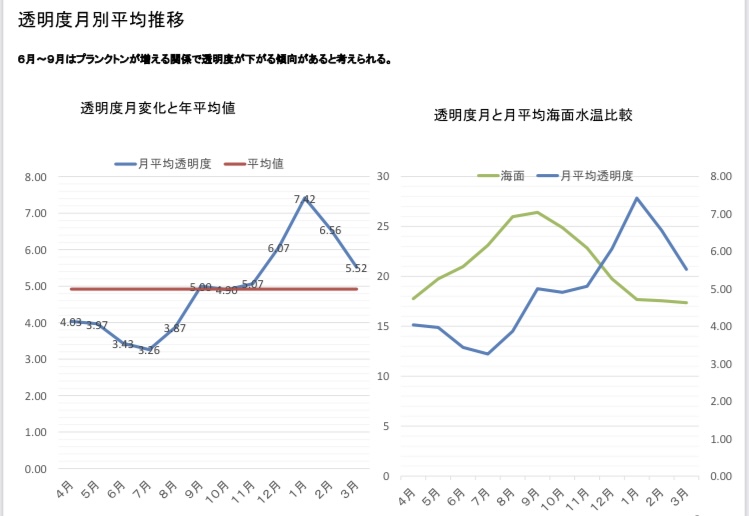
Vertical water temperature data at Katsuura underwater observatory: A future challenge is to collect data on time variations during the day and night.
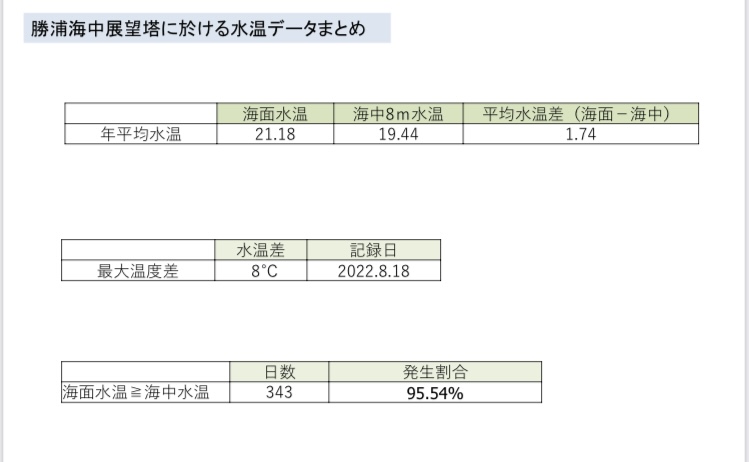
We know from experience that the water becomes suddenly cold just by diving 2-3m deep.
At Escot, we measured the actual difference in temperature using a temperature logger placed in a waterproof case. We found that
on a sunny summer day, the surface water temperature is up to 3°C lower than the water temperature at a depth of 3m.
One of the reasons for this is thought to be the sudden rise in sea surface temperature due to direct sunlight.
Vertical water temperature measured at 50cm intervals and 15-minute intervals


Measurements taken throughout the day on September 10th showed that the surface layer of the ocean up to a depth of 0.5m absorbed almost half of the solar heat.
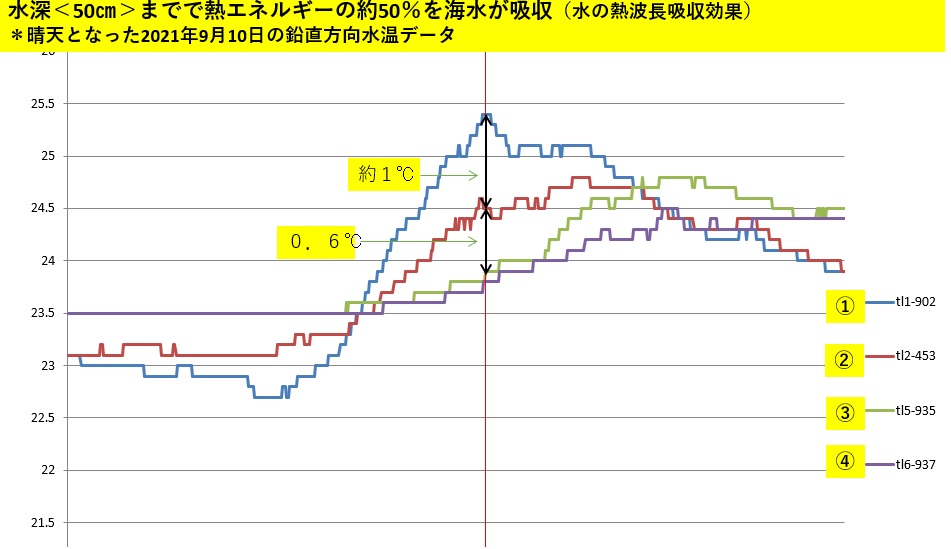
Water absorbs heat super quickly
A 1mm water layer absorbs almost all of the heat wavelengths in sunlight that are 3μm or longer.
This means that a large amount of water vapor is generated several centimeters above the ocean surface.
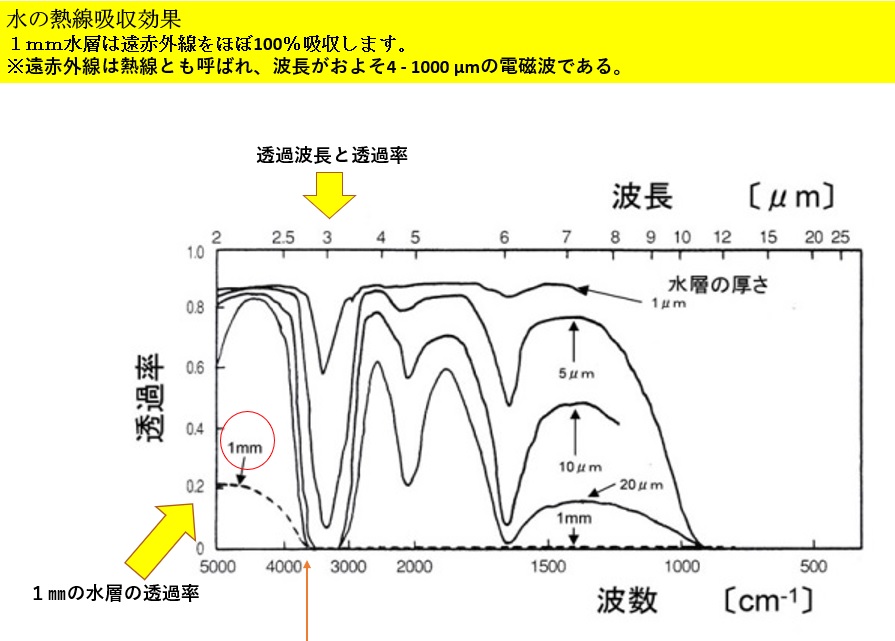
Return to the top of this page
*Estimated upwelling water volume and calculation formula
If the wave period is 5 seconds, the up and down movement repeats 17,280 times per day.
If the upwelling pipe has a displacement of 50 cm and a diameter of 20 cm, one wave will pump up about 15 liters of low-lying water.
This means that about 270 tons of water will be raised per day (not including loss due to water resistance) .
When a typhoon occurs in the South Seas and waves of about 4m wash up on the coast, the amount of upwelling is thought to be about eight times this amount, or 2,160 tons
. ☆It is expected that the energy of the typhoon will be used to vertically stir and propel the water, resulting in an automatic control effect that suppresses water vapor generation.

- Artificial upwelling using wave power to enhance fish stocks
- Source: Griffith University, Gold Coast, Australia
Return to the top of this page
*Regarding water vapor supply restrictions
Lowering the sea surface temperature by 1°C would reduce water vapor generation by about 7%. (IPCC)
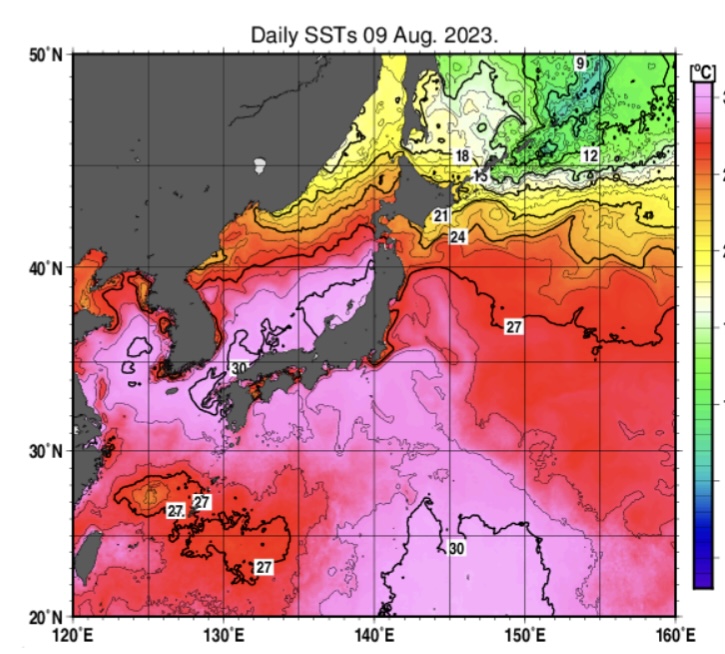
- Sea surface temperature on August 9, 2023
- Source: Japan Meteorological Agency website
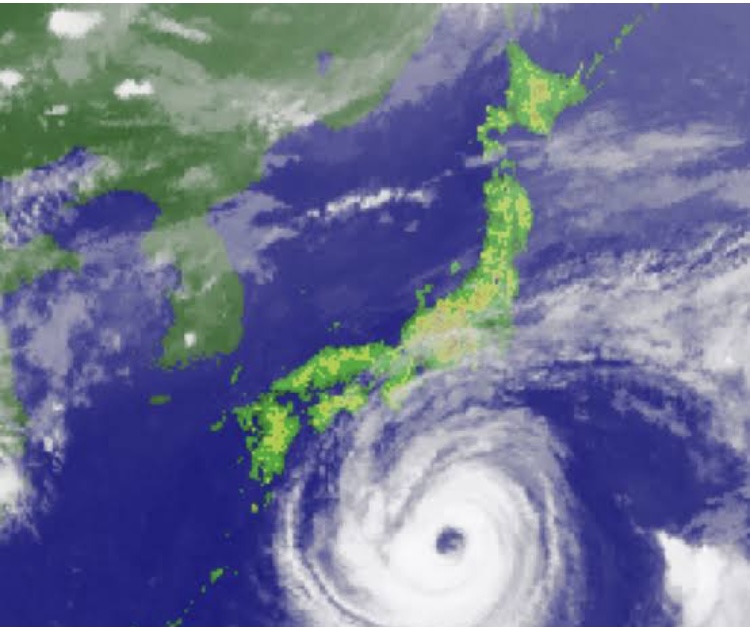
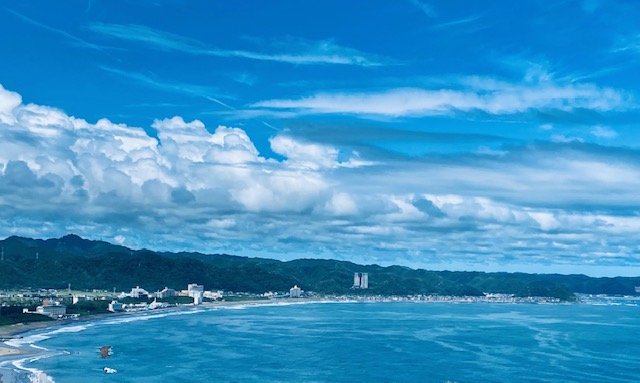
- Clouds and waves come to the coast from the sea. August 5, 2023
- Kamogawa City, Chiba Prefecture
* A system that can utilize typhoon energy
① A typhoon occurs in the ocean south of Japan
②Arrival of high waves/swells due to typhoons
③The wave-powered upwelling pump moves up and down and starts to pull up the cold water from the lower layers.
④ Decrease in sea surface temperature in the laying area due to cold water diffusion/diffusion of nutrients in the lower layers
⑤ Suppression of typhoon development and course change by suppressing water vapor supply
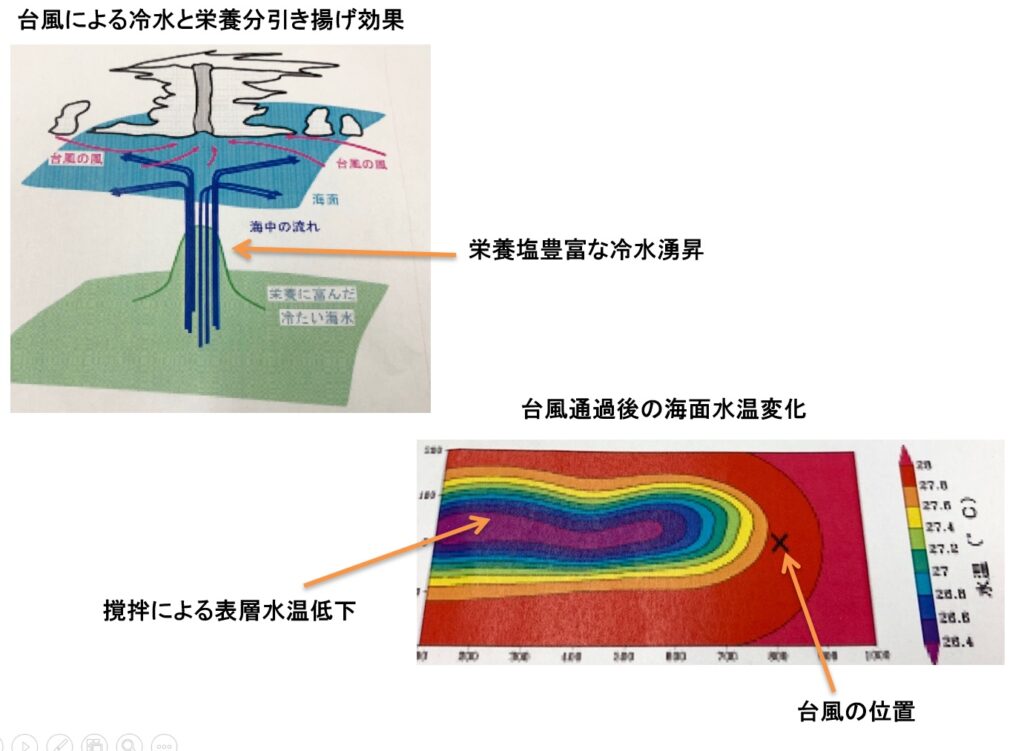
- Sea surface temperature drops as typhoon passes
- Seafloor nutrient redeployment
Return to the top of this page
* Aerobic decomposition of sludge = Suppression of methane and blue tide generation
① Organic matter in the bottom mud is aerobicly decomposed little by little over 24 hours = water + CO2 generation
② Suppression of methane generation = greenhouse effect reduced to 1/25
3) Increase in phytoplankton
④ Revitalization of coastal fishery resources

Return to the top of this page
* Aerobically decomposes organic matter that accumulates in depressions on the seabed after dredging, suppressing the generation of methane and hydrogen sulfide

① Upwelling of low-layer sediments (sludge, etc.)
②Contact with oxygen at the sea surface
③Aerobic decomposition
④ Suppression of blue tide and increase in phytoplankton
* Blue tide occurs due to wind from land, causing damage to fish and shellfish.
* Decomposes little by little in seafloor depressions 24 hours a day, 365 days a year.
Monitor sales catalogue ⇒here
Return to the top of this page
*Overseas cases
Off the coast of Hawaii, conducted by the University of Hawaii and the University of Oregon:
“Open ocean experiment using wave pump technology to control upwelling”
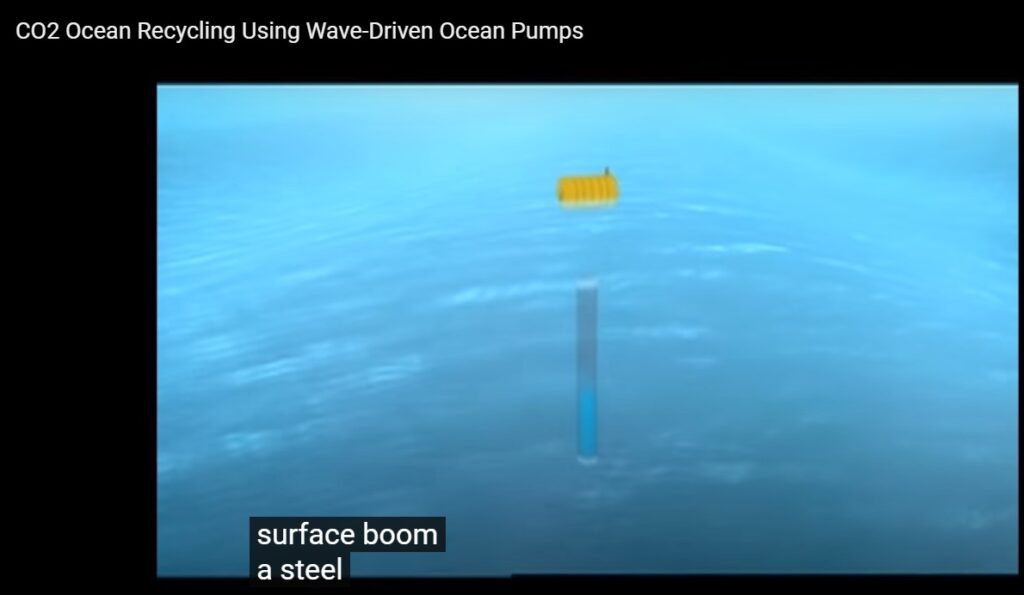
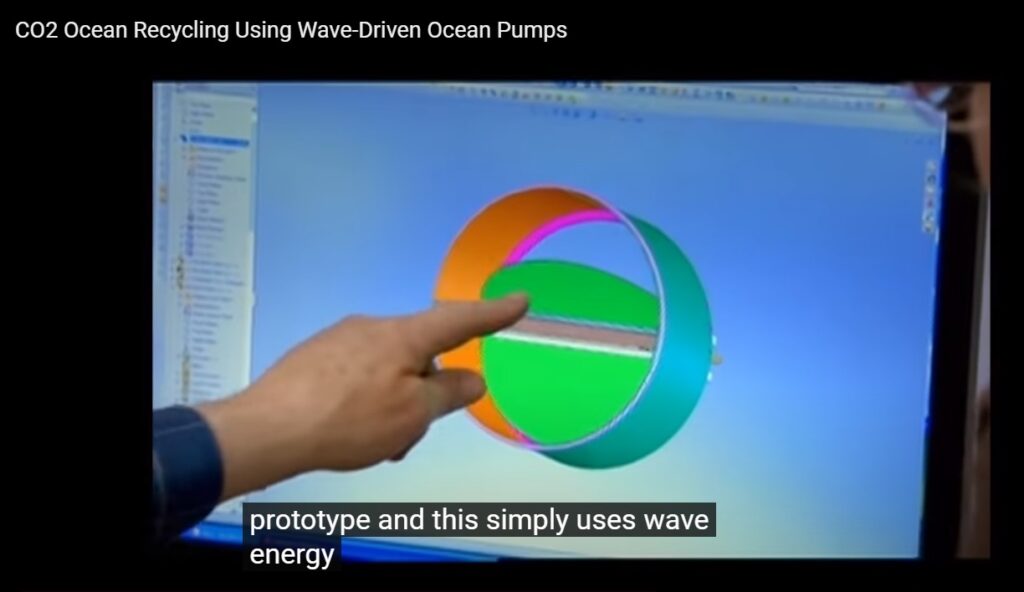
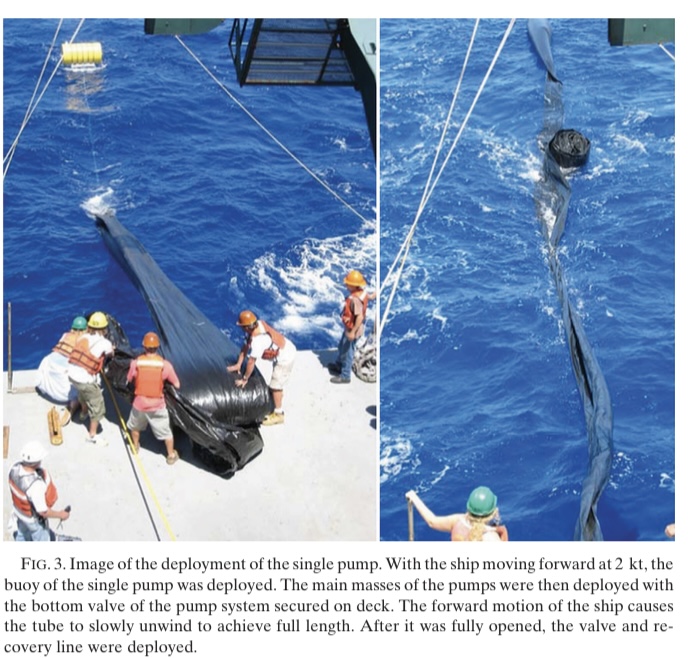
* summary
① Even small waves of a few centimeters can pump bottom water to the surface.
Demonstration tests conducted overseas so far have involved large upwelling pumps.
Many of these devices had check valve structures, which required a large displacement for upwelling.
②Improvements to the valve body and float buoy
* Wide left and right unequal valve opens and closes with minute amplitude
* Elastic material is used to generate closing force (usually gravity-type opening and closing)
*The beveled cut at the tip reduces both fluid resistance during ascent and drainage resistance.
*The buoy shape and uneven load give it a lifting effect.
3) DIY using generic products (low cost)
*Except for the check valve, sewer piping (VU pipes and fittings) available anywhere can be used.
* Old tires are used as elastic bodies to assist in opening and closing.
4. Easy to install, move, repair, remove and dispose of
*Upwelling pipes are PVC drainage pipes and are available cheaply anywhere in the country.
*Reduces waste separation work by using a single material
⑤ It has a combined effect with Stommel’s principle of permanent railway lines.
*The upwelling pipe is located near the water surface where the water temperature is high, so the principle of upwelling due to water temperature difference works even when there are no waves.
Return to the top of this page
Recruiting development project participants
Climate change is expected to increase the frequency of typhoons, heavy rains, and heavy snowfall.
It is known that typhoons rapidly intensify when sea surface temperatures reach 26.5°C or higher.
The characteristic of the wave upwelling pump is that the larger the wave (amplitude), the larger the volume of lower layer water it can pump up.
When the swells of a typhoon that occurred in the southern ocean arrive, the amount of upwelling increases dramatically (wave response effect).
This lowers the surrounding sea surface temperature, which is thought to control the development of the water.
In addition, during normal times, it cultivates the ocean, increases plankton, absorbs CO2, and revitalizes fishery resources.
NPO Escot is looking for individuals, companies, organizations, etc. to participate in our projects!
Project details here
Materials for project participating companies, organizations, and individuals
Monitor sales catalogue ⇒here
Return to the top of this page
*Examples/Paper
Testing on scallop farming rafts in Ishinomaki, Miyagi Prefecture
paper
Shibaura Institute of Technology Student Paper
Paper-
1Paper-
2Paper-
3Paper-
4Paper-
5Paper-6
Overseas university theses (Japanese translation)
“Artificial upwelling using wave power to enhance fish stocks”
Brian Kirke*
School of Engineering, Griffith University Gold Coast Campus, PMB 50, Gold Coast Mail Centre, Australia
University of Hawaii, University of Oregon
“Open Ocean Experiments of Controlled Upwelling Using Wave Pump Technology”
ANGELICQUE WHITE
Department of Marine and Atmospheric Sciences, Oregon State University, Corvallis, Oregon
KARINBJO¨RKMAN and ERIC GRABOWSKI
College of Marine and Earth Sciences and Technology, University of Hawaii at Manoa, Honolulu, Hawaii
RICARDO LETELIER
Department of Marine and Atmospheric Sciences, Oregon State University, Corvallis , Oregon
STEVE POULOS, BLAKE WATKINS, and DAVID KARL
College of Marine and Earth Sciences and Technology, University of Hawaii at Manoa, Honolulu, Hawaii
Corporate and research institute papers
Miyagi Prefectural Fisheries Experimental Station:
“Research on improving the meat content of cultured oysters by generating upwelling currents using natural energy”
Akira Kumagai and Akio Oshino
THE SEA FERTILIZATION EXPERIMENT BY UPWELLING DEEP OCEAN WATER –
TAKUMI PROJECT –Kazuyuki OUCHIPh.D.,Inc.
Monitor sales catalogue ⇒here
Return to the top of this page
Research activities are funded by the financial support of the following members:
8 supporting members:
Support amount: 5,000 yen/month
Kyodo Freighters
Shift Service Co., Ltd.
Yoshida Transport Co., Ltd.
Suzuyo Motor Transport Co., Ltd.
Kuwa Warehouse Co., Ltd.
Yamaraku Transport Co., Ltd.
Aobara Transport Co., Ltd.
Maruyama Transport Co., Ltd.
Regular members: 41 companies:
Support amount: 1,000 yen/month
Tanita Corporation
Japan Management Association Research Institute
Japan Freightliner Co., Ltd.
Japan Freight Railway Company
Sirius Consulting Co., Ltd. Hayakawa
Kairiku Yusou Co. , Ltd.
Gunma Jikahai Transport Co., Ltd.
Koriyama Truck Center Business Cooperative Association
Tokyo Boeki Transport Co.,
Ltd. Plandor Co.
, Ltd. APT
Eishin Transport Co., Ltd. Yoshida Transportation Co., Ltd.
Yamaniya
Logistics Service Co., Ltd.
Otake Transportation Co., Ltd.
Yashio Transportation Co., Ltd. Hoyu Service Co.,
Ltd.
Ibaraki Prefecture Transportation Business Cooperative Association
Sano City Hall
U-Palette (currently Desirée Co., Ltd.)
EF International Co., Ltd. Kanto
Service Co., Ltd. Tradeshift Japan Co., Ltd. Atom Logistics Co. , Ltd. Noshiro Transportation Co., Ltd. Tri-Wall Japan Co., Ltd. Shirai Eco Center Co., Ltd. Eco Planning Co., Ltd. Takust Co. , Ltd. Lockit Global Kowa Transportation Co., Ltd. Tatsumi Transport Co. , Ltd. OOCL Logistics (Japan) Co., Ltd. Kamio Masashi (Logistics Advisor) Gikogyo Co., Ltd. Minato Research Foundation Japan Transcity Co., Ltd. TRADE TECH JAPAN LLC. Takeshi Fujimoto (Doctor) Synthetic Corp. Japan Technology Co., Ltd. Oparts Co., Ltd. Marubeni Logistics Co., Ltd. International Forwarding Co., Ltd.
TRANSCENDIX LLC
Return to the top of this page
NPO Escot is looking for people to work with us!
New Membership Benefits
1. Matching support in the fields of total energy, energy conservation, environmental conservation, and logistics reform:
We support a wide variety of matching through a real network of over 5,000.
2. Consulting:
You can receive advice utilizing accumulated data on natural sciences, logistics, and humanities.
3. Participation in product, service, and system development:
You can take part in projects such as research and development and new planning.
4. Real-life interactions:
You can participate in human resource networking events held almost every month at member prices.
Value creation is possible based on the above track record.
Return to the top of this page
NPO Escot
4-17 Higashikamicho, Kashiwa City, Chiba Prefecture, 277-0011
Testing Center 768-22 Kamifuse, Onjuku Town, Isumi District, Chiba Prefecture
tel: +81-4-7166-4151
mobile: +81-80-4365-0861
fax: +81-4-7166-4128
https://www.npo-escot.org
ser.kashiwa@gmail.com
*If you would like the latest information, please contact us using the details below.